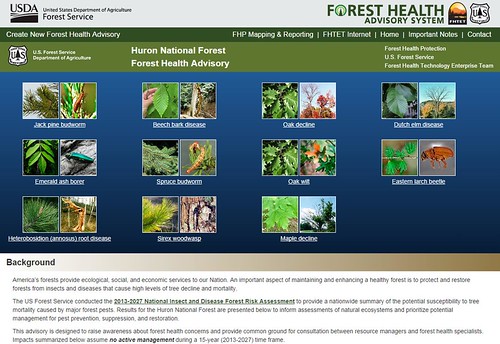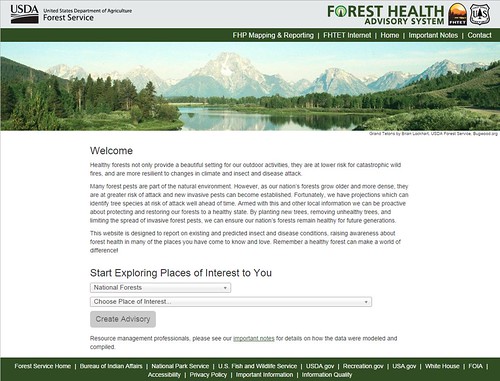
Using pest and tree photos, tables, and interactive maps, the Forest Health Advisory System provides vital information on future risks to forests across our nation. (U.S. Forest Service)
As our nation’s forests grow older and denser they are at greater risk of attack by pests, which can devastate some of more cherished national wildlands. Healthy forests not only provide a beautiful setting for our outdoor activities, they are at lower risk for catastrophic wild fires, and are more resilient to changes in climate and to insect and disease attack.
To address myriad issues facing our nation’s aging landscapes, the U.S. Forest Service has developed the Forest Health Advisory System, a web-based application that highlights potential future activity of more than 40 major forest pests and pathogens across 1.2 billion acres of treed lands.
“With the knowledge gained from this new application, we can be proactive about protecting and restoring our forests,” said Jim Hubbard, deputy chief for State and Private Forestry, the agency division that provides technical and financial assistance to landowners and resource managers to help sustain public and private forests. “By limiting the negative impacts of invasive and native forest pests, we can ensure our nation’s forests for future generations.”

Through a simple web interface, you can start exploring forest health in places of interest to you such as national forests and national parks. (U.S. Forest Service)
Information provided through the application is summarized by National Forest, National Park, U.S. Fish and Wildlife unit, and Tribal Lands. The information is designed to support information sharing and coordinated prevention and suppression activities for forest pest management across Federal agencies.
Loss of forest cover can have far-reaching affects to the full range of natural, cultural, and visitor services on public lands. In fact, national forests and parks already have lost iconic species such as American chestnut due to introduced forest pests, and are currently losing other iconic trees, such as flowering dogwood and hemlock in our Eastern forests and whitebark pine in our Western wildlands.

An American chestnut seedling is part of a national effort to restore the trees to eastern woodlands. The U.S. Forest Service developed an online application that highlights activities of major forest pests so that woodland owners can protect and restore their forests. While American chestnut trees can be found in the United States, many of them are threatened by blight and are not producing nuts. (Courtesy The American Chestnut Foundation)
No comments:
Post a Comment
Note: Only a member of this blog may post a comment.